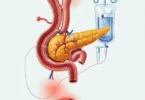MODY Diabetes
Maturity Onset Diabetes of the Young (MODY) was primarily the result of a defect in the beta cell function due to mutations in six genes. Therefore in all MODY forms insulin secretion is disturbed.
Approximately one to two percent of diabetics suffer from a MODY. This symptoms that are typically found in type 2 diabetes, experience in younger patients before the age of 25. Most of these young patients are not overweight, as is often the case with Type 2 diabetes. In addition, in a MODY no autoantibodies are usually detectable, which are typical sign of a type 1 diabetes. So this is so for special form of diabetes, which is therefore associated with the type 3 of diabetes.
There are known eleven different MODY types that are differentiated according to the causative genetic variation. All have one thing in common that, the insulin-producing beta cells of the pancreas are affected and therefore cannot produce enough insulin. Since it is a genetic defect so it can be inherited from one generation to next
Symptoms MODY diabetes
- Antibody detection GAD, IA-2 and / or islet cells negative
- Moderate (fasting) Hyperglycaemia (30-250 mg / dl, or 7-14 mM) Lj before the 30th
- Permanently lower insulin requirements (eg <0.5 U / kg / d)
- Gestational diabetes
- Early onset of disease
- Affected relative 1st degree
- Cystic kidney disease in patients or close relatives
- Positive glucose challenge test
- Renal glucosuria
- Type 2 diabetes or metabolic syndrome excluded.
Causes of MODY
The cause for the development of MODY are mutations in genes which are involved in the secretion of insulin in the beta cells. The effect of insulin itself is not disturbed, so there is no insulin resistance.
Types Of MODY
MODY are classified on the basis of which type of genes are affected or mutation take place in which type of genes.
Currently, 11 subtypes of MODY are known in which different genes are mutated. Most often, the cmost common type of MODY is types 2 and 3 (80 percent). The MODY types 2 and 4 are rather mild symptoms. The types 1, 3 and 5 are similar to the classic type 2 diabetes.
MODY Type 1, 3, 5, 7 and 9
This MODY types have defective genes that would encode proteins, which contribute to organ formation of liver and pancreas. (The proteins are called: HNF4α, HNF1α, HNF1β (TF2), KLF11, PAX4)
MODY Type 2
This is a mutation in the glucokinase gene (an enzyme in the liver that is responsible for the storage of sugar) in front.
MODY Type 4 and 6
The transcription of the insulin gene is disrupted (IPF-1 / PDX-1, NeuroD1 / β2).
MODY Type 8 and 10
MODY type 8 and 10 are very rare
MODY Type 11
Malfunctions of various pancreatic enzymes like pancreatic lysophospholipase, of the (pro) insulin gene or B-lymphocyte tyrosine kinase (BLK).






